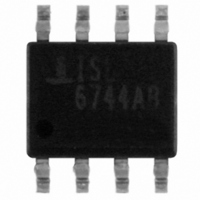ISL6744ABZ Intersil, ISL6744ABZ Datasheet - Page 9

ISL6744ABZ
Manufacturer Part Number
ISL6744ABZ
Description
IC CTRLR PWM DBL ENDED 8-SOIC
Manufacturer
Intersil
Datasheet
1.ISL6744AUZ.pdf
(18 pages)
Specifications of ISL6744ABZ
Pwm Type
Voltage Mode
Number Of Outputs
2
Frequency - Max
2MHz
Duty Cycle
100%
Voltage - Supply
9 V ~ 16 V
Buck
Yes
Boost
No
Flyback
No
Inverting
No
Doubler
No
Divider
No
Cuk
No
Isolated
No
Operating Temperature
-40°C ~ 105°C
Package / Case
8-SOIC (3.9mm Width)
Frequency-max
2MHz
Lead Free Status / RoHS Status
Lead free / RoHS Compliant
Available stocks
Company
Part Number
Manufacturer
Quantity
Price
Company:
Part Number:
ISL6744ABZ
Manufacturer:
Intersil
Quantity:
78
Company:
Part Number:
ISL6744ABZ
Manufacturer:
AKM
Quantity:
344
Part Number:
ISL6744ABZ
Manufacturer:
INTERSIL
Quantity:
20 000
Transformer Design
The design of a transformer for a half-bridge application is a
straightforward affair, although iterative. It is a process of
many compromises, and even experienced designers will
produce different designs when presented with identical
requirements. The iterative design process is not presented
here for clarity.
The abbreviated design process follows:
• Select a core geometry suitable for the application.
• Determine the turns ratio.
• Select suitable core material(s).
• Select maximum flux density desired for operation.
• Select core size. Core size will be dictated by the
• Determine maximum desired flux density. Depending on
• Determine the number of primary turns.
• Select the wire gauge for each winding.
• Determine winding order and insulation requirements.
• Verify the design.
For this application we have selected a planar structure to
achieve a low profile design. A PQ style core was selected
because of its round center leg cross section, but there are
many suitable core styles available.
Constraints of height, footprint, mounting preference, and
operating environment will affect the choice.
capability of the core structure to store the required
energy, the number of turns that have to be wound, and
the wire gauge needed. Often the window area (the space
used for the windings) and power loss determine the final
core size.
the frequency of operation, the core material selected, and
the operating environment, the allowed flux density must
be determined. The decision of what flux density to allow
is often difficult to determine initially. Usually the highest
flux density that produces an acceptable design is used,
but often the winding geometry dictates a larger core than
is indicated based on flux density alone.
FIGURE 6. TRANSFORMER SCHEMATIC
n
P
9
n
n
n
n
SR
S
S
SR
ISL6744
Since the converter is operating open loop at nearly 100%
duty cycle, the turns ratio, N, is simply the ratio of the input
voltage to the output voltage divided by 2.
The factor of 2 in the denominator is due to the half-bridge
topology. Only half of the input voltage is applied to the
primary of the transformer.
A PC44HPQ20/6 “E-Core” plus a PC44PQ20/3 “I-Core” from
TDK were selected for the transformer core. The ferrite
material is PC44.
The core parameter of concern for flux density is the
effective core cross-sectional area, Ae. For the PQ core
pieces selected:
Ae = 0.62cm
Using Faraday’s Law, V = N dΦ/dt, the number of primary
turns can be determined once the maximum flux density is
set. An acceptable Bmax is ultimately determined by the
allowable power dissipation in the ferrite material and is
influenced by the lossiness of the core, core geometry,
operating ambient temperature, and air flow. The TDK
datasheet for PC44 material indicates a core loss factor of
~400mW/cm
excitation. The application uses a 235kHz square wave
excitation, so no direct comparison between the application
and the data can be made. Interpolation of the data is
required. The core volume is approximately 1.6cm
estimated core loss is
1.28W of dissipation is significant for a core of this size.
Reducing the flux density to 1200 gauss will reduce the
dissipation by about the same percentage, or 40%.
Ultimately, evaluation of the transformer’s performance in
the application will determine what is acceptable.
From Faraday’s Law and using 1200 gauss peak flux density
(ΔB = 2400 gauss or 0.24 tesla)
Rounding up yields 4 turns for the primary winding. The peak
flux density using 4 turns is ~1100 gauss. From EQ. 7, the
number of secondary turns is 2.
The volts/turn for this design ranges from 5.4V at V
to 6.6V at V
(SR) windings may be set at 1 turn each with proper FET
selection. Selecting 2 turns for the synchronous rectifier
P
N
N
loss
=
=
------------------------ -
V
----------------------------- -
2 A
≈
V
OUT
•
IN
mW
---------- - cm
cm
V
IN
•
e
3
T
•
•
IN
•
ON
2
2
3
ΔB
with a ± 2000 gauss 100kHz sinusoidal
= 53V. Therefore, the synchronous rectifier
or 6.2e -5m
=
3
=
-------------- -
12 2
•
48
---------------------------------------------------- -
2 6.2 10
---------------
f
meas
•
f
•
act
53 2 10
=
•
=
•
2
2
0.4 1.6
•
–
5
•
•
–
6
0.24
•
200kHz
-------------------- -
100kHz
=
3.56
=
September 22, 2005
1.28
turns
3
IN
, so the
(EQ. 7)
(EQ. 8)
(EQ. 9)
FN9147.8
= 43V
W












